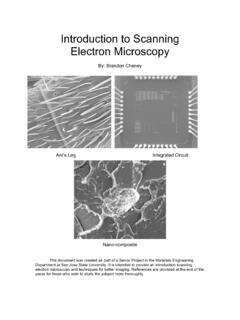Transcription of Chapter 2 Transmission and Pathogenesis of Tuberculosis
1 Chapter 2: Transmission and Pathogenesis of Tuberculosis19 Table of ContentsChapter Objectives .. 19 introduction .. 21 Transmission of TB .. 21 Pathogenesis of TB .. 26 Drug-Resistant TB (MDR and XDR) .. 35TB Classification System .. 39 Chapter Summary .. 41 References .. 43 Chapter ObjectivesAfter working through this Chapter , you should be able to Identify ways in which Tuberculosis (TB) is spread; Describe the Pathogenesis of TB; Identify conditions that increase the risk of TB infection progressing to TB disease; Define drug resistance; and Describe the TB classification 2 Transmission and Pathogenesis of TuberculosisChapter 2: Transmission and Pathogenesis of Tuberculosis21 IntroductionTB is an airborne disease caused by the bacterium Mycobacterium Tuberculosis (M. Tuberculosis ) (Figure ). M. Tuberculosis and seven very closely related mycobacterial species (M.)
2 Bovis, M. africanum, M. microti, M. caprae, M. pinnipedii, M. canetti and M. mungi) together comprise what is known as the M. Tuberculosis complex. Most, but not all, of these species have been found to cause disease in humans. In the United States, the majority of TB cases are caused by M. Tuberculosis . M. Tuberculosis organisms are also called tubercle bacilli. Figure Mycobacterium tuberculosisTransmission of TBM. Tuberculosis is carried in airborne particles, called droplet nuclei, of 1 5 microns in diameter. Infectious droplet nuclei are generated when persons who have pulmonary or laryngeal TB disease cough, sneeze, shout, or sing. Depending on the environment, these tiny particles can remain suspended in the air for several hours. M. Tuberculosis is transmitted through the air, not by surface contact. Transmission occurs when a person inhales droplet nuclei containing M.
3 Tuberculosis , and the droplet nuclei traverse the mouth or nasal passages, upper respiratory tract, and bronchi to reach the alveoli of the lungs (Figure ). M. Tuberculosis is carried in airborne particles, called droplet nuclei, of 1 5 microns in diameter. Infectious droplet nuclei are generated when persons who have pulmonary or laryngeal TB disease cough, sneeze, shout, or 2: Transmission and Pathogenesis of Tuberculosis22 Figure Transmission of TB TB is spread from person to person through the air. The dots in the air represent droplet nuclei containing tubercle that Determine the Probability of M. Tuberculosis Transmission There are four factors that determine the probability of Transmission of M. Tuberculosis (Table ). Table Factors that Determine the Probability of Transmission of M. Tuberculosis FactorDescriptionSusceptibilitySusceptib ility (immune status) of the exposed individualInfectiousnessInfectiousness of the person with TB disease is directly related to the number of tubercle bacilli that he or she expels into the air.
4 Persons who expel many tubercle bacilli are more infectious than patients who expel few or no bacilli (Table ) (see Chapter 7, TB Infection Control)EnvironmentEnvironmental factors that affect the concentration of M. Tuberculosis organisms (Table )ExposureProximity, frequency, and duration of exposure (Table ) Chapter 2: Transmission and Pathogenesis of Tuberculosis23 Table Characteristics of a Patient with TB Disease that Are Associated with InfectiousnessFactorDescriptionClinical Presence of cough, especially lasting 3 weeks or longer Respiratory tract disease, especially with involvement of the larynx (highly infectious) Failure to cover the mouth and nose when coughing Inappropriate or inadequate treatment (drugs, duration)Procedure Undergoing cough-inducing or aerosol-generating procedures ( , bronchoscopy, sputum induction, administration of aerosolized medications)Radiographic and laboratory Cavitation on chest radiograph Positive culture for M.
5 Tuberculosis Positive AFB sputum smear resultThe infectiousness of a person with TB disease is directly related to the number of tubercle bacilli that he or she expels into the air. Persons who expel many tubercle bacilli are more infectious than patients who expel few or no 2: Transmission and Pathogenesis of Tuberculosis24 Table Environmental Factors that Enhance the Probability that M. Tuberculosis Will Be TransmittedFactorDescriptionConcentratio n of infectious droplet nucleiThe more droplet nuclei in the air, the more probable that M. Tuberculosis will be transmittedSpaceExposure in small, enclosed spacesVentilationInadequate local or general ventilation that results in insufficient dilution or removal of infectious droplet nucleiAir circulationRecirculation of air containing infectious droplet nucleiSpecimen handlingImproper specimen handling procedures that generate infectious droplet nucleiAir PressurePositive air pressure in infectious patient s room that causes M.
6 Tuberculosis organisms to flow to other areasTable Proximity and Length of Exposure Factors that Can Affect Transmission of M. tuberculosisFactorDescriptionDuration of exposure to a person with infectious TBThe longer the duration of exposure, the higher the risk for transmissionFrequency of exposure to infectious personThe more frequent the exposure, the higher the risk for transmissionPhysical proximity to infectious personThe closer the proximity, the higher the risk for transmissionYoung children with pulmonary and laryngeal TB disease are less likely than adults to be infectious. This is because children generally do not produce sputum when they cough. However, Transmission from children can occur. Therefore, children and adolescents with TB disease should be evaluated for infectiousness using the same criteria as adults. These criteria include presence of cough lasting 3 weeks or longer; cavitation on chest radiograph; or respiratory tract disease with involvement of lungs, airways, or larynx (see Chapter 3, Testing for Tuberculosis Infection and Disease).
7 Young children with pulmonary and laryngeal TB disease are less likely than adults to be 2: Transmission and Pathogenesis of Tuberculosis25 Study How is TB spread? (circle the one best answer)A. From sharing eating utensils with an infected From person to person through the From insect bites. D. From touching surfaces that are contaminated with M. The probability that M. Tuberculosis will be transmitted depends (circle the one best answer)A. Susceptibility (immune status) of the exposed Infectiousness of the person with Proximity, frequency, and duration of Environmental factors that affect the concentration of M. Tuberculosis A, B, C, and D are the following statements about infectiousness true or false? (Choose the one best answer and write the letter for the correct answer on the line next to the question number.) Statement about InfectiousnessTrue or False____ The infectiousness of a person with TB disease is directly related to the number of tubercle bacilli that he or she expels into the Persons who expel few or no tubercle bacilli are just as infectious as those who expel many Tr u eB.
8 Which of the following environmental factors do NOT increase the probability that M. Tuberculosis will be transmitted? (circle the one best answer)A. Exposure in small enclosed Inadequate local or general ventilation that results in insufficient dilution or removal of infectious droplet Recirculation of air containing infectious droplet Improper specimen handling procedures that generate infectious droplet Negative pressure in an infectious TB patient s 2: Transmission and Pathogenesis of Tuberculosis26 Pathogenesis of TBInfection occurs when a person inhales droplet nuclei containing tubercle bacilli that reach the alveoli of the lungs. These tubercle bacilli are ingested by alveolar macrophages; the majority of these bacilli are destroyed or inhibited. A small number may multiply intracellularly and are released when the macrophages die. If alive, these bacilli may spread by way of lymphatic channels or through the bloodstream to more distant tissues and organs (including areas of the body in which TB disease is most likely to develop: regional lymph nodes, apex of the lung, kidneys, brain, and bone).
9 This process of dissemination primes the immune system for a systemic response. Further details about Pathogenesis of latent Tuberculosis infection (LTBI) and TB disease are described in Figure Pathogenesis of LTBI and TB of detail for boxes 2, 4, and 5 Droplet nuclei containing tubercle bacilli are inhaled, enter the lungs, and travel to the bacilliAlveoliTubercle bacilli multiply in the 2: Transmission and Pathogenesis of nodeLungSpineKidneyA small number of tubercle bacilli enter the bloodstream and spread throughout the body. The tubercle bacilli may reach any part of the body, including areas where TB disease is more likely to develop (such as the brain, larynx, lymph node, lung, spine, bone, or kidney). immune cells form a barrier shell (in this example, bacilli are in the lungs)Within 2 to 8 weeks, special immune cells called macrophages ingest and surround the tubercle bacilli.
10 The cells form a barrier shell, called a granuloma, that keeps the bacilli contained and under control (LTBI). breaks down and tubercle bacilli escape and multiplyIf the immune system cannot keep the tubercle bacilli under control, the bacilli begin to multiply rapidly (TB disease). This process can occur in different areas in the body, such as the lungs, kidneys, brain, or bone (see diagram in box 3).Infection occurs when a person inhales droplet nuclei containing tubercle bacilli that reach the alveoli of the 2: Transmission and Pathogenesis of Tuberculosis28 Latent Tuberculosis Infection (LTBI)Persons with LTBI have M. Tuberculosis in their bodies, but do not have TB disease and cannot spread the infection to other people. A person with LTBI is not regarded as having a case of TB. The process of LTBI begins when extracellular bacilli are ingested by macrophages and presented to other white blood cells.














